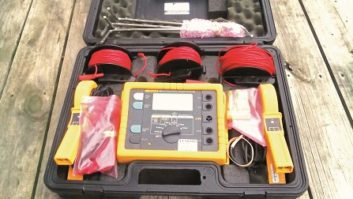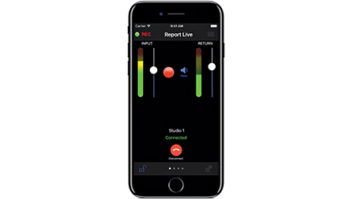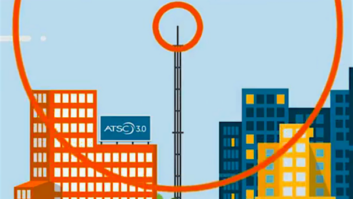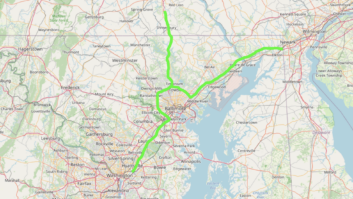Lightning Explained, Part 3
Jul 7, 2011 12:00 PM, By Amir Rizk
The scientific views expressed in this article are those of Dr. Farouk A.M. Rizk as explained by Amir Rizk. Dr. Farouk Rizk is the former VP (Research Laboratories), Hydro Quebec, and former Scientific Director at IREQ. Amir Rizk (B.Sc., phys, MBA) is VP of Lightning Electrotechnologies Inc and a student of Dr. Rizk. Any technical matters dealing with lightning protection adhered to previously published, peer reviewed material.
In 2000, a group of well-respected American scientists published a paper in the Journal of Applied Meteorology entitled �Lightning rod improvement studies�. In my view, this paper marks a turning point in the history of lightning protection science. Although the analysis of the data has evolved considerably since publication, the experimental design and data collection continues to educate and inspire.
What the American scientists showed, through long-term field studies of lightning rods exposed to real lightning, was that even objects as similar as sharp rods, moderately blunt rods and very blunt rods, placed at the same height in the same location, would interact differently with lightning and produce different results. The sharp rods were never struck whereas moderately blunt rods were struck most frequently.
Some criticism of the work was that the data was not statistically significant and this is true when the rods are grouped in terms of their geometric shape alone. However, if the rods are grouped in terms of their propensity to produce electric discharges under the slow varying electric field that precedes a lightning strike, the numbers make a very strong case.
Space charge shielding
The mechanism of space charge shielding was first observed in the 1970s during studies of design parameters for HVdc power lines. A main feature of all HV power line designs is their ability to resist the critical voltage surges that occur during normal switching operations as well as fault conditions. It was observed that if the dc line is actively producing discharges under the dc system voltage, something that is generally undesirable as it amounts to energy losses, the line is actually more resistant to the effects of these critical voltage surges when they appear.
It is interesting to note that the voltage waveform produced by these voltage surges or switching impulses, are very similar to the waveforms produced by the descending lightning leader, particularly in the last 30 percent before the peak, which is the most important part for leader initiation.
The analogy to lightning starts to become evident.
In a direct competition, under the same conditions, the object that produces the most discharge activity during the slowly varying dc-like electric field that precedes a lightning strike is the one that is the most resistant to the switching impulse-like peaks that result from a descending lightning leader. So it’s not merely a question of blunt or sharp but rather a question of more preceding discharge activity or less.
In the American field experiments, like the sharp rods, the largest most blunt rod (51mm) were never struck. It can be seen from the collected data that these larger blunter rods produced even more charges during the slowly varying electric field than the moderately blunt rod (19mm). This could only be explained by the presence of water droplets on the surface of the larger rods, which acted like conducting protrusions with small radii of curvature that caused them to produce charge at rates comparable to sharp rods. The same will be true of just about any object that is exposed to rain and has a surface area large enough to collect raindrops. The presence of raindrops on the surface of a conducting object, under high voltage, causes the water droplets to elongate and typically has an electric effect comparable to covering the object with needles.
The moderately blunt rods, which were struck the most, were small enough (19mm diameter and thus about 14 percent of the surface area of the 51mm rod) such that it was unlikely for a water droplet to settle on their surface. Furthermore the height used in the field tests, 6m masts, produced space potentials (effective applied voltages) very close to the level where the 19mm rod would just begin to produce discharges under the slowly varying field. Had the tests been conducted with mast heights of say 10m, they would not have detected any difference between the rods tested since they all would have been raging with similar discharge activity. Alternatively, had they chosen a test height of 1m, none of the rods would have produced discharges and again there would have been no observable difference.
— continued on page 2
Lightning Explained, Part 3
Jul 7, 2011 12:00 PM, By Amir Rizk
The mechanism of space charge shielding goes beyond simple rods but can also explain much of the seemingly mysterious behavior of lightning. For example, the reason tall towers are sometimes hit below the top may simply be that discharge activity from the tower top during the slowly varying electric field, shields the tower top in the same way as was observed with the sharp rods. And so when the descending leader arrives, a lower part of the tower is more prone to producing the upward connecting leader as compared to the tower top. But it will only occur if the slowly varying field reaches critical values for sufficient durations relative to the timing of the arrival of the descending leader. It is predictable but sporadic.
The Issue of space charge shielding is also shedding new light on rocket-triggered lightning experiments and the unique characteristics of that situation.
Can anything be done to prevent a lightning strike?
To the best of our understanding, there is absolutely nothing that can be done to influence any aspect of the descending stepped leader. However it is possible to influence a grounded structure’s propensity to produce upward leaders and from where on the structure such leaders would emanate.
The taller the structure and the more charge associated with the particular descending stepped lightning leader, the more the length of the upward leader from the structure can grow. So for a low structure with a large footprint, the probability of being struck will not be greatly influenced by the building’s ability to launch leaders. However, for tall slender towers, their ability to launch long leaders is the reason they are struck so frequently.
Influencing the possibility of producing upward leaders from a structure will thus have a much greater effect on taller more slender structures as compared to low massive ones.
For very tall towers, in the 100m range and more, the possibility of another kind of lightning strike comes into play. These structures can generate their own lightning. An upward flash is a lightning strike where the upward connecting leader is created without there having been any descending leader to which to connect. It is true that such strikes can be initiated by nearby flashes but the distinction is that these upward flashes do not connect with any descending lightning leader but rather, move toward localized charge centers in the clouds. Return strokes of comparable magnitudes to downward lightning result.
It is with these structures that the most can be done to influence the probability of a direct strike. The production of charges at the tops of these very tall towers can shield them enough to raise the required space potential for upward leader initiation to the point of significantly suppressing their occurrence.
— continued on page 3
Lightning Explained, Part 3
Jul 7, 2011 12:00 PM, By Amir Rizk
It is not clear however that this effect can be significantly enhanced through the use of devices that use sharp conductive points. Any conducting protruding object or even the edges or corners of such tall structures would also produce charges via the same mechanism, streamers and in similar rates. Therefore the effect is mostly determined by the particular nature or waveform produced by the slowly varying field.
How we got here
When Ben Franklin first proposed mounting needle sharp iron rods at the tops of buildings, he didn’t think that they would be hit by lightning. He initially thought that such rods would discharge the clouds and so his choice of using sharp tipped rods had no connection with the mechanism that he had accidentally discovered: upward leader initiation. Franklin’s genius was to mount any grounded metallic object above a structure and to adapt his views to what he observed rather than proposed.
Modern knowledge of electric discharges however confirms that the sharp-tipped rod is the worst conceivable shape for a lightning rod. This is due to an intrinsic quality of the rod’s geometry, more than any other simple shape, it is prone to production of electric discharge under the slowly varying electric fields that precede lightning strikes.
So for the last 250 years we have been using a device, the sharp tipped lightning rod, in a situation for which its shape is perfectly unsuited. Of course the effect of rain limits the performance of any other shape, which is why this detail has eluded us for so long. Also since the effect becomes more pronounced with increasing structure height, as we continue to build taller structures, the more these effects will become apparent.
Interestingly Nicola Tesla nearly solved the problem. He somehow recognized that the sharp-tipped rod’s propensity for discharges was a bad thing. And so he designed a device, with the intent of resisting the production of electric discharges. However what Tesla did not recognize is that when exposed to rain and covered in water droplets, like almost all objects, his device produced discharges comparable to a sharp rod and thus function as an ordinary rod and not as Tesla had intended.
New technology
With a modern understanding of how grounded objects interact with lightning, and with full consideration for the effects of space charge shielding, Lightning Electrotechnologies Inc has developed a series of lightning rods based in peer reviewed science.
The F-SAT (Field Sensitive Air Terminal)
A patented electrode/lightning rod with a unique shape that resists the production of electric discharges under intense electric fields and under rain and thus never self protects via space charge shielding and always maintains the maximum attractive area for its position.

F-SAT
When properly placed, lightning protection systems employing the F-SAT ensures that any upward leaders emanating from a structure will be from the F-SAT and not below or nearby. The F-SAT is suitable wherever lightning protection is needed and can be used to enhance an NFPA 780 compliant system. Other installation methodology options using currently employed and recommended practices for power lines can be applied to any structure with the possibility of significant savings and without compromising security. (IEEE STD 1243, EPRI Reference Book)
The F-SAT is not a one-size-fits-all solution. A 60m high building corner does not experience the same electric field intensification as a 60m high slender tower. F-SATs come in a number of sizes designed to meet these varying conditions.
It is important to note that the F-SAT does not offer an enhanced zone of protection as compared to any conducting object; it merely prevents the type of degradation to a lightning rod”s attractive area described above. All conducting objects except the F-SAT are subject to that kind of degradation.
The streamer-inhibiting electrode
This is the complete opposite strategy as compared to the F-SAT. Here the objective is to maximize the effects of space charge shielding. The Streamer Inhibitor is a patented composite electrode consisting of a conducting support structure for a coil, which is made of micro thin conducting fibers. Under the same ambient field conditions this device will produce more charge than any other known configuration.

Toroidal streamer inhibitor
Furthermore it does so without producing streamers, it produces electric discharges exclusively in the pulse-less glow mode over a very broad voltage range. Glow-mode corona is a silent and typically invisible discharge phenomenon. It produces a dc current rather than the sub-microsecond pulses associated with streamers. Below a critical rate of some tens of kilovolts per microsecond, the Streamer Inhibitor also maintains glow mode corona under switching impulses or very fast voltage rise rates. Therefore in addition to producing large volumes of charge, even after the arrival of the descending stepped leader, the Streamer Inhibitor, unlike a point discharge device, continues to produce space charges that suppresses streamers, which in turn suppresses leaders in a defined although limited area around the Inhibitor.
The Streamer Inhibitor represents the most that can be done to reduce a structure”s lightning-attractive area, suppress leader formation and reduce the probability of a direct strike to a structure. This can have a tremendous effect on tall slender towers or isolated masts but very limited effects on low, massive structures. However the location or origin of any upward connecting leader can be significantly influenced by the simultaneous use of Streamer Inhibitors and F-SATs and reduce risk at sensitive points on low structures.
Streamer Inhibitors are modular and come in the form of toroidal air terminals of various sizes as well as a long conductor.
Lightning Explained, Part 1
Part one of this three-part series explains the basics of lightning and its energy potential….
Lightning Explained, Part 2
Part two of this three-part series explains ways to protect systems from lightning damage….
References
1. NFPA International, Standards Council Decision (Long Form): D301-26
2. F.A.M. Rizk, “Modeling of Lightning Exposure of Buildings and Massive Structures” IEEE Trans. On Power Delivery, Vol. 24, No.4, pp. 1987-1998 October 2009
3. M.A. Uman and V.A. Rakov, “A Critical review of Nonconventional Approaches to Lightning Protection” American Meteorology Society, December, 2002
4. C.B. Moore, W. Rison, J. Mathis and G. Aulich, “Lightning rod improvement studies”, Journal of Applied Meteorology, Vol.39, pp.593-609, 2000
5. F.A.M. Rizk, “Modeling of Lightning Exposure of Sharp and Blunt Rods” IEEE Trans. On Power Delivery, Vol. 25, No.4, pp 3122 -3132, October, 2010
6. D. Mackerras, M. Darveniza, A.C. Liew, ” Review of claimed enhanced lightning protection of buildings by early streamer emission air terminals”, IEE Proc.-Sci Meas. Technol., Vol. 144, No. 1. January 1997
7. I.D. Chalmers FIEE, J.C. Evans and W.H. Siew MIEE, IEE Proc.-Sci Technol, Vol. 146, No. 2, March, 1999
8. N. Knudsen, F. Iliceto, “Flashover tests on large air gaps with dc voltages and with switching surges superimposed on dc voltage”, IEEE Trans., Vol. PAS-89, No.5/6, pp. 781-788, May/June 1970
9. F.A.M. Rizk, “Rocket-Triggered Lightning: Modeling of Trigger-Wire Corona Effects” International Conference on Lightning Protection, ICLP, Cagliari, Italy, September 2010
10. F.A.M. Rizk, “Modeling of lightning Incidence to tall structures.”, IEEE Trans., Vol. PWRD-9, pp. 162-171, Jan. 1994
11. US PATENT 1,266,175
12. F.A.M. Rizk, “Analysis of Space charge Generating Devices for Lightning Protection: Performance in Slow Varying Fields”, IEEE Trans. On Power Delivery, Vol. 25, No. 3, pp. 1996-2006, July 2010
13. F.A.M. Rizk, “Exposure of overhead conductors to direct lightning strikes: Modeling of positive streamer Inhibition”, IEEE Trans. on Power Delivery, Vol. 26, No. 2, pp. 1156 – 1165, April 2011











